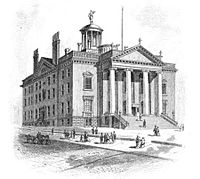70th New York State Legislature
| 70th New York State Legislature | |||||
|---|---|---|---|---|---|
|
|||||

The Old State Capitol (1879)
|
|||||
| Overview | |||||
| Jurisdiction | New York, United States | ||||
| Term | January 1 – December 31, 1847 | ||||
| Senate | |||||
| Members | 32 | ||||
| President | Lt. Gov. Addison Gardiner (D), until July 4 | ||||
| Temporary President | Albert Lester (D), from February 12 | ||||
| Party control | Democratic (21-10-1) | ||||
| Assembly | |||||
| Members | 128 | ||||
| Speaker | William C. Hasbrouck (W) | ||||
| Party control | Whig (72-56) | ||||
| Sessions | |||||
|
|||||
| 1st | January 5 – May 13, 1847 |
|---|---|
| 2nd | September 8 – December 15, 1847 |
The 70th New York State Legislature, consisting of the New York State Senate and the New York State Assembly, met from January 5 to December 15, 1847, during the first year of John Young's governorship, in Albany.
Under the provisions of the New York Constitution of 1821, 32 Senators were elected on general tickets in eight senatorial districts for four-year terms. They were divided into four classes, and every year eight Senate seats came up for election. Assemblymen were elected countywide on general tickets to a one-year term, the whole Assembly being renewed annually.
On May 13, 1845, an "Act recommending a Convention of the people of this State" was passed, submitting at the next State election to the people the question whether they wanted to call a convention to amend the State Constitution. At the State election in November 1845, the question was answered in the affirmative. The Constitutional convention met from June 1 to October 9, 1846. The amended Constitution abolished rotative renewal of the Senate, required all legislators to be elected in single districts, made the State cabinet offices elective by popular ballot, and made major changes in the judicial system. The new Constitution was submitted to the electorate at the next State election for ratification.
On March 30, 1846, the Legislature re-apportioned the Assembly districts: Chautauqua, Chenango, Columbia, Cortland, Madison, Ontario and Wyoming counties lost one seat each; Albany, Erie, Kings and St. Lawrence counties gained one seat each; and New York City gained three seats. The total number of assemblymen remained 128.
On May 13, 1846, the Legislature re-apportioned the Senate districts: Kings County was transferred from the 1st to the 2nd District; Ulster County from the 2nd to the 3rd District; and Schenectady County from the 3rd to the 4th District.
At this time there were two major political parties: the Democratic Party and the Whig Party. The Democratic Party was split into two factions: the "Barnburners" and the "Hunkers." The radical abolitionists appeared as the Liberty Party. The Anti-Rent Party nominated some candidates, but mostly cross-endorsed Whigs or Democrats, according to their opinion on the rent issue.
...
Wikipedia
